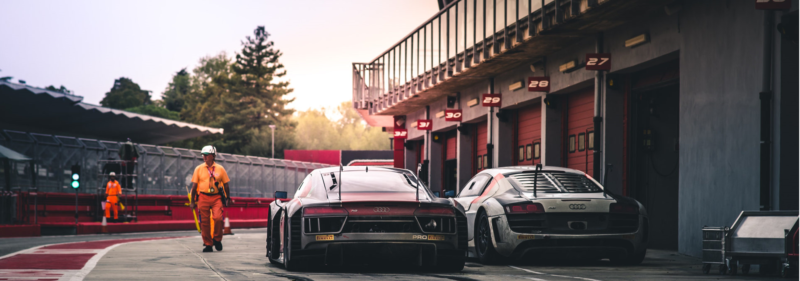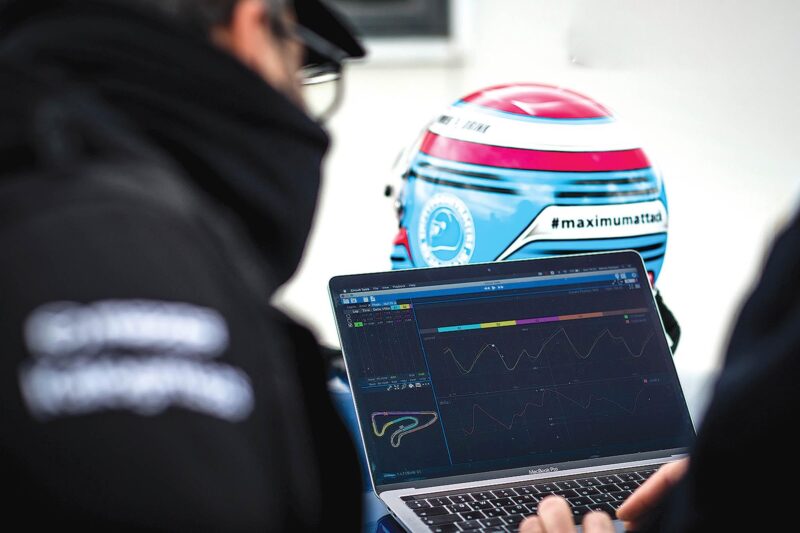

The lines depict the exact track areas where the most time can be gained by improving the driving or the vehicle setup. The section might be the entry, the apex, or the exit of turn, or even a combination of them. VPRating will indicate one area with red and one with orange colour, where red is the area in which the most time can be shaved off.
The VPRating algorithm identifies and simulates the perfect lap your vehicle could achieve at the specific session and track. It then compares your session’s best lap with the perfect simulated lap and provides you with the areas of the track where you can improve the most.
Your personal data analysis will indicate the areas of the track where you’re loosing time based on the laps you have completed. On the contrary, Coaching will indicate the areas of the track where you’re loosing the most time compared to the ideal simulated time. Therefore, the misguidance from your personal data analysis may occur if you’re consistently approaching specific corners in a non ideal way, meaning you will never know if you could be faster in these areas. To simplify things, your personal data compares you against yourself, whilst Coaching compares you against perfection.
The Acceleration is being affected by the power to weight ratio, Cd (drag coefficient), gear ratio, slipstreaming, tire pressures and alignment.
Yes, the slipstreaming results in higher Acceleration figures. Also if the slipstreaming is not consistent, it may result in lower Driving Scores.
The VPRating VC is an index number that indicates the performance of the vehicle for the given track and conditions. The bigger the number is, the faster the vehicle is at the specific track.
The easiest way is to use the “Per-Lap” data provided, which allows you to compare critical data such as lateral, braking, and acceleration. This helps you instantly understand the impact caused by any differences in driving, car setup, or track conditions. For more detailed data comparisons, the VPRating platform offers a downloadable .vbo file for every session. This file contains driving data that can be used to further analyze and compare different laps.
In many cases, this is true. However, there are instances where the morphology between tracks differs significantly. Some tracks are more technical than others, posing a greater challenge in achieving top driving scores. Therefore, VPRating advises comparing and using Driving Scores from the same track as a reference.
Given that you have the same or worse vehicle capabilities, a better lap time will result in a better Driving Score.
This might happen for various reasons but most probably the overall grip level, due to track conditions or tyre wear, may be lower which results in a less capable vehicle. You were awarded a better Driving Score because you managed to use more efficiently the currently available vehicle capabilities.
A solid, balanced and reliable vehicle can provide consistent performance and more chances for high Driving Scores. Also consider using a vehicle that suits your driving skills and a certified driving coach.
A 100% Driving Score is achieved during the ideal simulated lap as calculated by our algorithm. During the simulation, we calculate the perfect lap time that could be achieved based on the vehicles top achievable capabilities during each driving stint. It is not impossible to achieve the perfect score, although it is very challenging to drive flawlessly and be absolutely perfect throughout the lap at the absolute limit of the vehicle and track.
The VPRating algorithm is able to identify multiple driving styles and therefore to provide accurate Lateral g information regardless of the driving style. Obviously a minimum driving effort is required and as it is known, the power of a tool lies in the hands of its user.
VPRating can be utilized at racetracks, autocross events, hill climbs, and virtually any closed course circuit. VPRating is provided as a B2B service. If you wish to use VPRating data, please check with the track-day organizers to see if VPRating is available through their services.
Indeed, the WOT data are extracted from the simulated lap. This occurs due to the fact that WOT is meant to be an indication of the vehicles capability of remaining at full throttle throughout the track. Since most drivers are not able to extract 100% of the vehicle capabilities, it is more objective to extract WOT data from the simulated lap.
All those who use “Vehicle Performance Rating” [VPRating] do so at their own risk and responsibility. Each user or, in the case of minors or persons who do not have full legal capacity and liability, the responsible adult agrees and acknowledges that:
1.1 They are aware of the inherent element of risk involved in the sport and accept responsibility for the exposure of themselves, others, other property and their own vehicle to such inherent risk whilst using VPRating.
1.2 They are solely liable and responsible for the safety of themselves, their vehicle and their other properties.
1.3 They accept responsibility for any injury, damage and indirect damage.
1.4 Their vehicle is in good order, properly maintained and they are officially licenced, fit and healthy to drive the vehicle.
1.5 VPRating bears no responsibility or liability for any injury, damage, indirect damage or loss to the extent that such occurred while using any aspect, characteristic, data, mechanism or item otherwise related with Vehicle Performance Rating and the equipment that Vehicle Performance Rating provides and/or is connected with.
1.6 They accept the VPRating results.
1.7 They accept that VPRating may update the software, firmware, or hardware that VPRating use.
“Vehicle Performance Rating” [VPRating] works on any kind of car, kart, motorbike, e-scooter or truck where the GNSS device has been properly fitted.
3.1 Lap. This is the actual lap number.
3.2 Driving Score [%]. The Driving Score is an index that describes the percentage of the vehicle’s capabilities that the driver utilized during the session or the lap.
3.3 Lap time [m]. This is the logged time of the lap.
3.4 Min Apex Speed [km/h]. This is the minimum logged speed at the turn of the smallest ratio during the lap.
3.5 Max Speed [km/h]. This is the maximum logged speed during the lap.
3.6 Distance [metres]. This is the covered distance during the lap.
3.7 Acceleration [g]. This is the maximum sustained acceleration at the straight lines, of the session or the lap.
3.8 Lateral [g]. This is the maximum sustained lateral grip of the session or the lap.
3.9 Braking [g]. This is the maximum sustained deceleration of the session or the lap.
3.10 VC [index]. This is the vehicle capability index of the session or the lap.
3.11 WOT [index]. The percentage of wide open throttle of the ideal lap.
3.12 Coaching. Advanced insight of the two turns of the track where the driver can gain the most time by improving his driving or the vehicle setup.
4.1 ASTERISK. VPRating realised that the actual performance of the vehicle may not match the data collected during this session. [*] at Driving Score number.
4.2 LOW GPS. Low accuracy of GNSS data. Only Lap time, Speed and Distance are provided.
4.3 INVALID. Τhe VPRating algorithm realised that the actual performance of the vehicle does not match the data collected during this session. Only Lap time, Min apex speed, Max speed and Distance are provided.
4.4 TRACK LIMIT. Track limits violation. No results are provided.
4.5 INVALID (DISTANCE). Not enough data, driven during the driving session.
“Vehicle Performance Rating” [VPRating] is designed to provide a unique combination of data at a high level of accuracy. However the accuracy of VPRating results may be compromised at some extent in the cases listed below:
5.1 Significantly different traction level on specific part of the track. Reasons might include a very bumpy section, a part of the course where there has been a liquid spill, a very wet spot while the rest of the route is dry, etc. (possibility for strict Driving Score).
5.2 Vehicles that due to their downforce, can produce significantly higher lateral grip levels during turns of the specific track. This might apply at vehicles that exceed 1.7g Maximum Sustained Lateral Grip.
5.3 Users who for several reasons, don’t provide a minimum effort to extract the vehicles capabilities. Τhis could happen when they are not familiar with the track, or with the vehicle, or for various other reasons.
5.4 Laps with traffic.
5.5 Sessions with “short shifting”.
5.6 Endurance driving sessions.
5.7 Rainy conditions.
5.8 Short kart tracks.
5.9 If the GNSS device is not mounted correctly. The VPRating data are comparable when the GNSS device is located in the same position on the vehicles.
6.1 Current version: 1.9.6
Active Duration: 29/11/2022, 00:01am UTC time-now
Updates:
6.2 Software update applies in every further VPRating action. All existing Personal, Overall and VPRating League results are updated accordingly.
6.3 Previous version: 1.9.5
Active duration: 29/4/2022 – 28/11/2022